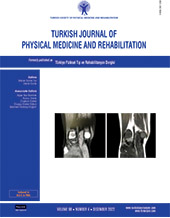Kinesiophobia and associated factors in patients with traumatic lower extremity amputation
Patients and methods: This cross-sectional study included 52 male patients (mean age: 37.8±8.7 years; range, 18 to 65 years) with traumatic LLA between March and July 2021. Kinesiophobia level was measured with the Tampa Scale for Kinesiophobia. Pain intensity and prosthesis satisfaction were evaluated with the Visual Analog Scale. The Falls Efficacy Scale-International was used for the assessment of fear of falling. The Nottingham Health Profile was used to evaluate the quality of life.
Results: The percentage of the patients with a high level of kinesiophobia was 40.4%. Kinesiophobia was significantly correlated with residual limp pain intensity (r=0.317, p=0.022), the number of falls (r=0.284, p=0.041), fear of falling (r=0.495, p=0.001), and quality of life (r=0.512, p=0.001). No significant correlations between kinesiophobia and intact limb pain intensity, low back pain intensity, or prosthesis satisfaction were detected. Regression analysis showed that the physical activity subscale score of the Nottingham Health Profile was a statistically significant predictor of high kinesiophobia scores.
Conclusion: The findings suggest that limitations in physical activity were independently associated with kinesiophobia in patients with traumatic LLA. Fear and avoidance behaviors, which may limit physical activity, should be considered in the evaluation of individuals with LLA.
Keywords : Amputation, fear of falling, kinesiophobia, pain intensity, quality of life

















